Fiction about fiction is metafiction, which allow writers and readers to examine the trickiness of storytelling. Here are the best works of metafiction in chronological order. For a much longer list, see my post 111 Best Works of Metafiction.
1. Cervantes, Miguel. Don Quixote. 1605.
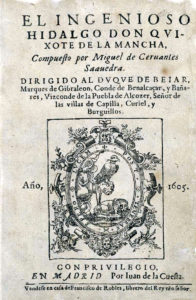 Parodying chivalric romance by contrasting the lofty story-lines with the hard-edge of reality, Cervantes established two genres: metafiction and realism. Often called the first modern novel, it could also be called the first post-modern novel. It’s a book about books and the effects they have upon our lives, especially when we try to live out our fictions in the real world. Cervantes challenges the notion of objective history and blurs the distinction between fiction and nonfiction. The events are told by a series of authors nested one within the other like Chinese boxes, which draws attention to how stories are told and how each teller alters the tale. In the second volume, Don Quixote and Sancho Panza hear of the publication of the first. They meet a reader and talk to him about their own book. Don Quixote, expecting a heroic romance, is angered by his portrayal as a deluded, old fool, thus becoming a critic of his own book. (Learn more about this funny and insightful novel in my book Narrative Madness and my many posts about it.)
Parodying chivalric romance by contrasting the lofty story-lines with the hard-edge of reality, Cervantes established two genres: metafiction and realism. Often called the first modern novel, it could also be called the first post-modern novel. It’s a book about books and the effects they have upon our lives, especially when we try to live out our fictions in the real world. Cervantes challenges the notion of objective history and blurs the distinction between fiction and nonfiction. The events are told by a series of authors nested one within the other like Chinese boxes, which draws attention to how stories are told and how each teller alters the tale. In the second volume, Don Quixote and Sancho Panza hear of the publication of the first. They meet a reader and talk to him about their own book. Don Quixote, expecting a heroic romance, is angered by his portrayal as a deluded, old fool, thus becoming a critic of his own book. (Learn more about this funny and insightful novel in my book Narrative Madness and my many posts about it.)
Online Edition / Link to Amazon
Historical importance to metafiction: 5
Metafictional inventiveness: 5
Literary reputation: 5
Enjoyability: 5!!! (It’s long, but actually two books: a novel and its sequel. Try the first to see how funny it is!)
2. Shakespeare, William. The Tempest. 1611.
Shakespeare’s penultimate play is generally recognized as the aging playwright’s farewell to theater, literature, art, and and even life itself. When Prospero interrupts a masque and a country dance, a play within a play, he suggests that reality is as unreal and unsubstantial as theater:
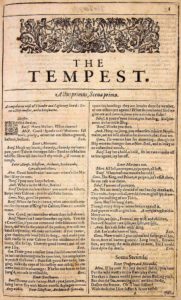
Our revels now are ended. These our actors,
As I foretold you, were all spirits, and
Are melted into air, into thin air:
And like the baseless fabric of this vision,
The cloud-capp’d towers, the gorgeous palaces,
The solemn temples, the great globe itself,
Yeah, all that it inherit, shall dissolve,
And, like this insubstantial pageant faded,
Leave not a rack behind. We are such stuff
as dreams are made on; and our little life
is rounded with a sleep. (4.1.148-158).
The characters and scenery, Prospero tells us, evaporated when the play ended because they were made of nothing, a “baseless fabric.” By association, words like “insubstantial pageant” also include the play Prospero appears in, The Tempest, as we can tell from the reference to the “great globe,” or the Globe Theater. The metaphor extends to life because the “great globe” also means the world. When he says, “Yea, all that it inherit, shall dissolve,” he is talking about humanity, including the audience. Like the characters in a play, we too will vanish, leaving not a wisp behind, for “We are such stuff as dreams are made on.” Thus, the bard undermines the reality of our reality with his metaplay. (This excerpt is from my post The Stuff That Dreams are Made of: The Real, the Unreal, and the Maltese Falcon.)
Online edition / Link to Amazon
Historical importance to metafiction: 4
Metafictional inventiveness: 2
Literary reputation: 5
Enjoyability: 5
3. The Arabian Nights. Ed. Daniel Heller-Roazen and Muhsin Mahdi. Trans. Husain Haddawy. First English edition 1706.
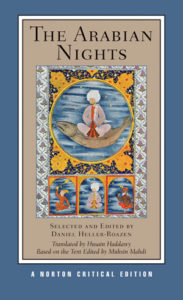 The Arabian Nights is a story of stories. Not only is it an complex, interwoven tapestry of stories within stories within stories, it is also a story about the power of stories to saves lives, to tame murderers, and to change the world, as night after night Shahrazad tells stories to forestall her execution. While the story continues, she lives. If the story ends, she dies. Thinking to save himself from the cunning of women, the king has unwittingly placed himself in a vulnerable position between orgasm and murder: under the tongue of the most cunning of women, the quintessential storyteller, Shahrazad. (Read my paper Eros and the Arabesque: The Serial Proliferation of Life in The Arabian Nights.)
The Arabian Nights is a story of stories. Not only is it an complex, interwoven tapestry of stories within stories within stories, it is also a story about the power of stories to saves lives, to tame murderers, and to change the world, as night after night Shahrazad tells stories to forestall her execution. While the story continues, she lives. If the story ends, she dies. Thinking to save himself from the cunning of women, the king has unwittingly placed himself in a vulnerable position between orgasm and murder: under the tongue of the most cunning of women, the quintessential storyteller, Shahrazad. (Read my paper Eros and the Arabesque: The Serial Proliferation of Life in The Arabian Nights.)
Link to Amazon
Historical importance to metafiction: 5
Metafictional inventiveness: 5
Literary reputation: 4
Enjoyability: 5!!!
4. Sterne, Laurence. The Life and Opinions of Tristram Shandy, Gentleman. 1759-1767.
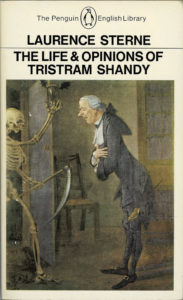 A postmodern book long before postmodernism. Tristram Shandy begins to tell the story of his life, but needs to digress to set up the scene of his conception, then needs another digression to set that scene up and so on. The story is told backwards, yet still manages to move forward in a series of progressive digressions, making us aware of the conventions of storytelling. Inventive typography, including an infamous black page, draws our attention to the materiality of the book: end pages, binding, ink, and paper. The book lays bare the devices of fiction, causing Viktor Shklovsky to proclaim, “Tristram Shandy is the most typical novel of world literature.” (Read my post Tristram Shandy ****s Up the Page.)
A postmodern book long before postmodernism. Tristram Shandy begins to tell the story of his life, but needs to digress to set up the scene of his conception, then needs another digression to set that scene up and so on. The story is told backwards, yet still manages to move forward in a series of progressive digressions, making us aware of the conventions of storytelling. Inventive typography, including an infamous black page, draws our attention to the materiality of the book: end pages, binding, ink, and paper. The book lays bare the devices of fiction, causing Viktor Shklovsky to proclaim, “Tristram Shandy is the most typical novel of world literature.” (Read my post Tristram Shandy ****s Up the Page.)
Link to Amazon
Historical importance to metafiction: 5
Metafictional inventiveness: 5
Literary reputation: 4
Enjoyability: 4 (Very funny book!)
5. Joyce, James. Ulysses. 1918-1920.
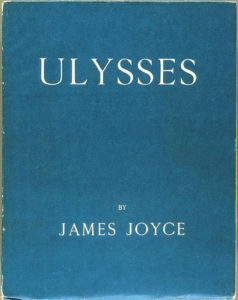 A book of books. First of all, the book parallels Homer’s Odyssey, pulling this foundational text of western literature into the world of Dublin in the early twentieth century. Secondly, the book strives to be a book of all books, a compendium of nearly every imaginable type of text, including: fiction, poetry, song, theatrical script (including stage directions), romance magazine and novelette, newspaper article, advertisement, correspondence, legal document, encyclopedia, mythology, biblical text, catechism, pun, parody, monologue and free indirect discourse. One chapter recreates the history of the English language in literature, moving from prose heavily influenced by Latin up to modern slang. Honorable mention: Finnegan’s Wake. 1939: perhaps the most metafictional work of all, but practically unreadable. (Read my post Hisstory Repleats Herself: James Joyce’s Finnegan’s Wake.)
A book of books. First of all, the book parallels Homer’s Odyssey, pulling this foundational text of western literature into the world of Dublin in the early twentieth century. Secondly, the book strives to be a book of all books, a compendium of nearly every imaginable type of text, including: fiction, poetry, song, theatrical script (including stage directions), romance magazine and novelette, newspaper article, advertisement, correspondence, legal document, encyclopedia, mythology, biblical text, catechism, pun, parody, monologue and free indirect discourse. One chapter recreates the history of the English language in literature, moving from prose heavily influenced by Latin up to modern slang. Honorable mention: Finnegan’s Wake. 1939: perhaps the most metafictional work of all, but practically unreadable. (Read my post Hisstory Repleats Herself: James Joyce’s Finnegan’s Wake.)
Link to Amazon
Historical importance to metafiction: 5
Metafictional inventiveness: 5
Literary reputation: 5
Enjoyability: 2 (It has entertaining parts, but you have to plow through a lot of overwrought prose, like the encyclopedia section.)
6. Pirandello, Luigi. Six Characters in Search of an Author: A Comedy in the Making. 1921
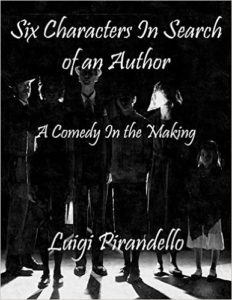 When this puzzling classic of meta-theater, which blurs the line between theater and reality, was first performed in Rome in the Teatro Valle, it was greeted with shouts of “Manicomio” (“Madhouse!”). The Actors are rehearsing a play by Luigi Pirandello called Mixing It Up when six characters, who are not fully formed, show up. They are looking for a writer to flesh them out. As The Director hears their stories, which include a possibly sexual relationship between The Father and The Stepdaughter, he decides that the group will put on the play with The Actors as actors, but The Stepdaughter laughs when she sees them perform the roles of The Characters because they get their voices and gestures all wrong. The Characters insist that they should play The Characters since they are already those people. Absurdities abound as the play builds to a tragic ending, but did those characters really die or was it just theater?
When this puzzling classic of meta-theater, which blurs the line between theater and reality, was first performed in Rome in the Teatro Valle, it was greeted with shouts of “Manicomio” (“Madhouse!”). The Actors are rehearsing a play by Luigi Pirandello called Mixing It Up when six characters, who are not fully formed, show up. They are looking for a writer to flesh them out. As The Director hears their stories, which include a possibly sexual relationship between The Father and The Stepdaughter, he decides that the group will put on the play with The Actors as actors, but The Stepdaughter laughs when she sees them perform the roles of The Characters because they get their voices and gestures all wrong. The Characters insist that they should play The Characters since they are already those people. Absurdities abound as the play builds to a tragic ending, but did those characters really die or was it just theater?
Online version / Link to Amazon
Historical importance to metafiction: 4
Metafictional inventiveness: 5
Literary reputation: 3
Enjoyability: 3
7. Borges, Jorge Luis. Ficciones. 1941-2, 1944, 1956
 A rich and delicious smorgasbord of metafiction. Here is one example: In the short story “Borges and I” (1960), the narrator discusses Borges as a separate person, a fictional persona created by the media and academia. The author Borges likes many of the same things as the man, such as hourglasses and maps, but he merely copies these tastes from the real person “in a vain sort of way that turns them into the accoutrements of an actor.” The writer Borges, in other words, is affecting the characteristics of the real person. The man refuses, however, to be limited by the meaning of his name, so he reinvents himself whenever his author function becomes too confining, but the rebellion just gets incorporated into his new image. Thus, he calls his life a point-counterpoint between the author and himself, but “everything winds up being lost to me, and everything falls into oblivion, or into the hands of the other man.” The short piece ends in the midst of an identity crisis: “I am not sure which of us it is that’s writing this page.” Indeed, who does not know who is writing? The real Borges, the author Borges, or the narrator? (This extract is from my book Narrative Madness.)
A rich and delicious smorgasbord of metafiction. Here is one example: In the short story “Borges and I” (1960), the narrator discusses Borges as a separate person, a fictional persona created by the media and academia. The author Borges likes many of the same things as the man, such as hourglasses and maps, but he merely copies these tastes from the real person “in a vain sort of way that turns them into the accoutrements of an actor.” The writer Borges, in other words, is affecting the characteristics of the real person. The man refuses, however, to be limited by the meaning of his name, so he reinvents himself whenever his author function becomes too confining, but the rebellion just gets incorporated into his new image. Thus, he calls his life a point-counterpoint between the author and himself, but “everything winds up being lost to me, and everything falls into oblivion, or into the hands of the other man.” The short piece ends in the midst of an identity crisis: “I am not sure which of us it is that’s writing this page.” Indeed, who does not know who is writing? The real Borges, the author Borges, or the narrator? (This extract is from my book Narrative Madness.)
Link to Amazon
Historical importance to metafiction: 5
Metafictional inventiveness: 5
Literary reputation: 5
Enjoyability: 4
8. Nabokov, Vladimir. Pale Fire. 1962.
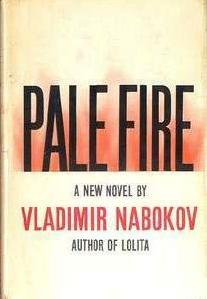 Ostensibly, a poem and its commentary, the commentator Dr. Charles Kinbote reveals more about himself, an eccentric, homosexual professor, and the colorful, gay king of Zembla, Charles the Beloved, than the writer of the poem, American John Francis Shade. Kinbote stalks and spies on Shade because he wants to impregnate him with his own history, which he hopes Shade will turn into great poetry. (Spoiler alert!) Gradually we realize that king and Kinbote are the same and many other characters are figments of his imagination. On the last page Kinbote, looking to future possibilities, hints, “I may assume other disguises, other forms . . . I may turn up yet, on another campus, as on old, happy, healthy, heterosexual Russian, a writer in exile.” The “heterosexual Russian, a writer in exile” is Vladimir Nabokov, the author of the novel, so did he invent Kinbote or did Kinbote invent him? (Extracted from my post “Zemblan Pizza Resembles Nabokov.”) Honorable mention: Lolita. 1955.
Ostensibly, a poem and its commentary, the commentator Dr. Charles Kinbote reveals more about himself, an eccentric, homosexual professor, and the colorful, gay king of Zembla, Charles the Beloved, than the writer of the poem, American John Francis Shade. Kinbote stalks and spies on Shade because he wants to impregnate him with his own history, which he hopes Shade will turn into great poetry. (Spoiler alert!) Gradually we realize that king and Kinbote are the same and many other characters are figments of his imagination. On the last page Kinbote, looking to future possibilities, hints, “I may assume other disguises, other forms . . . I may turn up yet, on another campus, as on old, happy, healthy, heterosexual Russian, a writer in exile.” The “heterosexual Russian, a writer in exile” is Vladimir Nabokov, the author of the novel, so did he invent Kinbote or did Kinbote invent him? (Extracted from my post “Zemblan Pizza Resembles Nabokov.”) Honorable mention: Lolita. 1955.
Link to Amazon
Historical importance to metafiction: 5
Metafictional inventiveness: 5
Literary reputation: 5
Enjoyability: 4
9. Barthelme, Donald. Snow White. 1967.
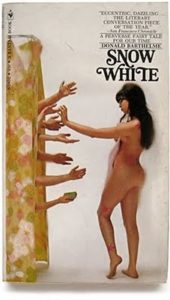 Not only is Snow White metafictional because it totally reinvents the story of Snow White (one of the first novels to do so), but also because it includes many metafictional elements such as a quiz at the end of the first part which asks the reader in a questionnaire, “Do you like the story so far? Yes ( ) No ( ).” The story even asks the reader to participate in the production of meaning: “Has the work, for you, a metaphysical dimension? Yes ( ) No ( ) / What is it (twenty-five words or less)?” (Check out my post “Do You Like the Story So Far? Metafiction in Bathelme’s Snow White.”) Honorable mention: Sixty Stories, 1981. Lots of crazy stories!
Not only is Snow White metafictional because it totally reinvents the story of Snow White (one of the first novels to do so), but also because it includes many metafictional elements such as a quiz at the end of the first part which asks the reader in a questionnaire, “Do you like the story so far? Yes ( ) No ( ).” The story even asks the reader to participate in the production of meaning: “Has the work, for you, a metaphysical dimension? Yes ( ) No ( ) / What is it (twenty-five words or less)?” (Check out my post “Do You Like the Story So Far? Metafiction in Bathelme’s Snow White.”) Honorable mention: Sixty Stories, 1981. Lots of crazy stories!
Link to Amazon
Historical importance to metafiction: 4
Metafictional inventiveness: 5
Literary reputation: 4
Enjoyability: 4
10. Barth, John. Lost in the Funhouse. 1968.
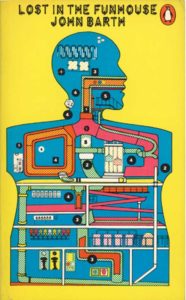 We are lost in our fictions, lost in the funhouse of our own inventions. Barth argued in his essay “The Literature of Exhaustion” that writers had used up traditional forms of fiction to the point that were exhausted, but this freed up writers like Calvino and Borges to reinvent it, as Barth does in this collection of stories. The book opens with a kind of frame story: two printed strips which read “ONCE UPON A TIME THERE” and “WAS A STORY THAT BEGAN,” which readers are supposed to tape together into a Möbius strip, an eternal loop which reads: “ONCE UPON A TIME THERE WAS A STORY THAT BEGAN ONCE UPON A TIME THERE WAS A STORY THAT BEGAN ONCE UPON A TIME . . .” This is just the beginning of a journey, the first story is one of my favorites, “Night-Sea Journey,” which tells of a character swimming through the dark to some unknown destination. Turns out that the main character is a sperm looking for an egg, symbolizing the genetic and cultural heritage of humanity, an existential story of how we find meaning in an apparently meaningless existence. (I write about “Night-Sea Journey” in my popular post “Our Cultural and Genetic Heritage.”) Honorable mention: The Sot-Weed Factor. 1960.
We are lost in our fictions, lost in the funhouse of our own inventions. Barth argued in his essay “The Literature of Exhaustion” that writers had used up traditional forms of fiction to the point that were exhausted, but this freed up writers like Calvino and Borges to reinvent it, as Barth does in this collection of stories. The book opens with a kind of frame story: two printed strips which read “ONCE UPON A TIME THERE” and “WAS A STORY THAT BEGAN,” which readers are supposed to tape together into a Möbius strip, an eternal loop which reads: “ONCE UPON A TIME THERE WAS A STORY THAT BEGAN ONCE UPON A TIME THERE WAS A STORY THAT BEGAN ONCE UPON A TIME . . .” This is just the beginning of a journey, the first story is one of my favorites, “Night-Sea Journey,” which tells of a character swimming through the dark to some unknown destination. Turns out that the main character is a sperm looking for an egg, symbolizing the genetic and cultural heritage of humanity, an existential story of how we find meaning in an apparently meaningless existence. (I write about “Night-Sea Journey” in my popular post “Our Cultural and Genetic Heritage.”) Honorable mention: The Sot-Weed Factor. 1960.
Link to Amazon
Historical importance to metafiction: 5
Metafictional inventiveness: 5
Literary reputation: 4
Enjoyability: 4
11. Vonnegut, Kurt. Slaughterhouse-Five, or The Children’s Crusade: A Duty-Dance with Death. 1969.
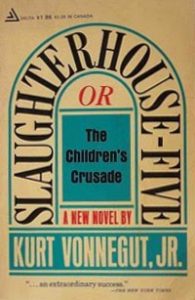 The main character Billy Pilgrim is captured by aliens and gets unstuck in time, traveling backward and forward, disturbing the usual chronological story-line and blurring the line between fiction and reality in the historical novel focused on the Battle of the Bulge. To make things stranger, the author appears in his own book. The narrator says of a character, “That was I. That was me. That was the author of this book.” Honorable mention: Breakfast of Champions. 1973.
The main character Billy Pilgrim is captured by aliens and gets unstuck in time, traveling backward and forward, disturbing the usual chronological story-line and blurring the line between fiction and reality in the historical novel focused on the Battle of the Bulge. To make things stranger, the author appears in his own book. The narrator says of a character, “That was I. That was me. That was the author of this book.” Honorable mention: Breakfast of Champions. 1973.
Link to Amazon
Historical importance to metafiction: 2
Metafictional inventiveness: 2
Literary reputation: 5
Enjoyability: 5
12. Goldman, William. The Princess Bride: S. Morgenstern’s Classic Tale of True Love and High Adventure. 1973.
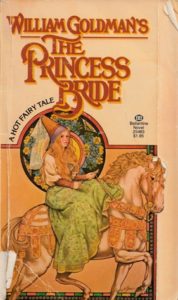 This novel–one of my favorites–is a novel about reading a novel–or at least the good parts. The first line reads, “This is my favorite book in all the world, though I have never read it.” The narrator is supposedly William Goldman himself but is a fictionalized version, reflecting back on his childhood at a time when he did not like reading. Once when he was sick, his father began reading the best parts of a long novel by S. Morgenstern to him. The adult narrator, his younger self, and his father continually comment on and interact with the novel, demonstrating the power of fiction to delight and enlighten. The narrator claims not to have added any scenes except a reunion scene between Westley and Buttercup, which the publisher would not allow him to include, so he invites readers to write the publisher and ask for the scene. Those who did so received a letter explaining legal issues with the Morgenstern estate, which has been repeatedly updated. The metafiction, therefore, continues well beyond the novel.
This novel–one of my favorites–is a novel about reading a novel–or at least the good parts. The first line reads, “This is my favorite book in all the world, though I have never read it.” The narrator is supposedly William Goldman himself but is a fictionalized version, reflecting back on his childhood at a time when he did not like reading. Once when he was sick, his father began reading the best parts of a long novel by S. Morgenstern to him. The adult narrator, his younger self, and his father continually comment on and interact with the novel, demonstrating the power of fiction to delight and enlighten. The narrator claims not to have added any scenes except a reunion scene between Westley and Buttercup, which the publisher would not allow him to include, so he invites readers to write the publisher and ask for the scene. Those who did so received a letter explaining legal issues with the Morgenstern estate, which has been repeatedly updated. The metafiction, therefore, continues well beyond the novel.
Link to Amazon
Historical importance to metafiction: 4
Metafictional inventiveness: 4
Literary reputation: 4
Enjoyability: 5!!!
13. Calvino, Italo. If On a Winter’s Night a Traveller. 1979.
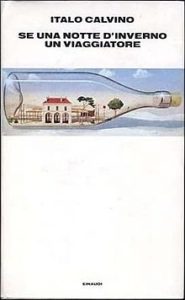 A book about reading. The novel opens with this line: “You are about to begin reading Italo Calvino’s new novel, If on a winter’s night a traveller. Relax. Concentrate. Dispel every other thought. Let the world around you fade.” Since the character “you” is a reader of the book, and you (yes, I mean you) are reading the book, it would appear that the fictional and actual readers are the same and this relationship is discussed in several chapters, further blurring the distinction between fiction and reality. Calvino’s book within a book, a mise en abyme, begins in the next chapter. The narrator is caught up in some sort of complex plot at a railroad station, but when the action starts to build, the novel is interrupted because of a printer’s error. You take it back to the bookstore where you meet a lovely young lady Ludmilla and the desire to talk to her about books motivates you to keep reading. This metafictional masterpiece then alternates between chapters explaining what you do to get ready to read the first chapters of books of various genres, which then influence the narrative of you and Ludmilla. What you end up with is one of the best discussions of the act of reading in literature. Honorable mentions: Cosmicomics. 1965. Invisible Cities. 1972.
A book about reading. The novel opens with this line: “You are about to begin reading Italo Calvino’s new novel, If on a winter’s night a traveller. Relax. Concentrate. Dispel every other thought. Let the world around you fade.” Since the character “you” is a reader of the book, and you (yes, I mean you) are reading the book, it would appear that the fictional and actual readers are the same and this relationship is discussed in several chapters, further blurring the distinction between fiction and reality. Calvino’s book within a book, a mise en abyme, begins in the next chapter. The narrator is caught up in some sort of complex plot at a railroad station, but when the action starts to build, the novel is interrupted because of a printer’s error. You take it back to the bookstore where you meet a lovely young lady Ludmilla and the desire to talk to her about books motivates you to keep reading. This metafictional masterpiece then alternates between chapters explaining what you do to get ready to read the first chapters of books of various genres, which then influence the narrative of you and Ludmilla. What you end up with is one of the best discussions of the act of reading in literature. Honorable mentions: Cosmicomics. 1965. Invisible Cities. 1972.
Link to Amazon
Historical importance to metafiction: 5
Metafictional inventiveness: 5
Literary reputation: 4
Enjoyability: 3
14.. Dick, Philip K. Valis. 1981
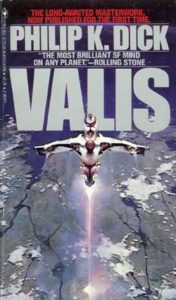 The main character of this autobiographical science fiction novel is named Horselover Fat, a stand-in for the author. “Philip” in Greek etymology means “horse lover,” as “dick” means “fat in German. This fictionalization of self allow Dick more objectively to examine himself and his bizarre experiences with religious visions, drugs, schizophrenia, and/or contact with a Vast Active Living Intelligence System (VALIS), yet Philip K. Dick appears himself as a character as a calmer, more pragmatic side of himself, a character who criticizes and argues with his other fictional side. The central questions of this book and all of Dick’s books, which are the most influential science fiction novels of the modern age, are “What is real?” and “What is identity?” Honorable mention: The Man in the High Castle. 1962.
The main character of this autobiographical science fiction novel is named Horselover Fat, a stand-in for the author. “Philip” in Greek etymology means “horse lover,” as “dick” means “fat in German. This fictionalization of self allow Dick more objectively to examine himself and his bizarre experiences with religious visions, drugs, schizophrenia, and/or contact with a Vast Active Living Intelligence System (VALIS), yet Philip K. Dick appears himself as a character as a calmer, more pragmatic side of himself, a character who criticizes and argues with his other fictional side. The central questions of this book and all of Dick’s books, which are the most influential science fiction novels of the modern age, are “What is real?” and “What is identity?” Honorable mention: The Man in the High Castle. 1962.
Link to Amazon
Historical importance to metafiction: 2
Metafictional inventiveness: 3
Literary reputation: 4
Enjoyability: 3 (His non-autobiographical novels are more fun.)
15. Ende, Michael. The Neverending Story. 1983.
 A novel about a boy named Bastian Balthazar Bux reading and interacting with a novel, an example of a mise en abyme. The act of reading becomes an act of creation, as the book responds to things he says and thinks and does, blurring the lines between fiction and reality. The boy eventually recognizes that he is the main character in the book within a book. His quest is to prevent the nothingness from wiping out everything. The nothing represents a growing lack of imagination in the modern world, where stories are prepared and packaged for modern consumers so that readers do not have to use their own imaginations. The main character saves the fictional world and his own by bringing his imagination to life.
A novel about a boy named Bastian Balthazar Bux reading and interacting with a novel, an example of a mise en abyme. The act of reading becomes an act of creation, as the book responds to things he says and thinks and does, blurring the lines between fiction and reality. The boy eventually recognizes that he is the main character in the book within a book. His quest is to prevent the nothingness from wiping out everything. The nothing represents a growing lack of imagination in the modern world, where stories are prepared and packaged for modern consumers so that readers do not have to use their own imaginations. The main character saves the fictional world and his own by bringing his imagination to life.
Link to Amazon
Historical importance to metafiction: 4
Metafictional inventiveness: 4
Literary Reputation: 4
Enjoyability: 5!!!
16. Moore, Alan and Dave Gibbons. Watchmen. 1986-1987.
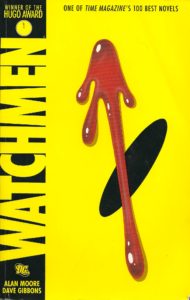 A comic about comics; this meta-comic gives a brief history of superhero comics, then proceeds to deconstruct the genre as it examines the realistic, complex characters who dress up in tights and fight crime. In the comic, we can read another comic over the shoulder of a character; this is an example of a mise en abyme, a work within a work, and it helps us to understand comics and the complex morality of the larger tale. (See my post Watchmen: A Comic.) Honorable mention: The League of Extraordinary Gentlemen. 1999-present.
A comic about comics; this meta-comic gives a brief history of superhero comics, then proceeds to deconstruct the genre as it examines the realistic, complex characters who dress up in tights and fight crime. In the comic, we can read another comic over the shoulder of a character; this is an example of a mise en abyme, a work within a work, and it helps us to understand comics and the complex morality of the larger tale. (See my post Watchmen: A Comic.) Honorable mention: The League of Extraordinary Gentlemen. 1999-present.
Link to Amazon
Historical importance to metafiction: 4
Metafictional inventiveness: 4
Literary reputation: 5 (First comic to get on Time Magazine’s 100 Best Books of All Time)
Enjoyability: 5!!!
17. Auster, Paul. New York Trilogy. 1986.
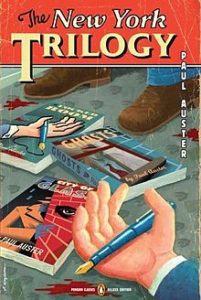 A trilogy of mystery novellas under one cover, but these ain’t Dashiell Hammett mysteries undercover. The mysteries Auster explores are the ultimate mysteries. What is mystery? What is identity? The ultimate goal is not to find the murderer but to discover why humans write about themselves. In “City of Glass,” Paul Auster is a character, a writer who is writing about the authorship of Don Quixote (the main character, Daniel Quin shares these initials), but Auster is distinct from the unnamed author of the story. In “Ghosts,” all the characters are named after colors. Blue has been hired by White to investigate Black, but loses his identity in the investigation of the other who is somehow himself. In “The Locked Room” (which references a popular trope of mysteries dating back to Edgar Alan Poe’s “The Murders of the Rue Morgue”), a writer has disappeared, so the writer of this novella publishes the other’s work and replaces him in his family. Why ask why?
A trilogy of mystery novellas under one cover, but these ain’t Dashiell Hammett mysteries undercover. The mysteries Auster explores are the ultimate mysteries. What is mystery? What is identity? The ultimate goal is not to find the murderer but to discover why humans write about themselves. In “City of Glass,” Paul Auster is a character, a writer who is writing about the authorship of Don Quixote (the main character, Daniel Quin shares these initials), but Auster is distinct from the unnamed author of the story. In “Ghosts,” all the characters are named after colors. Blue has been hired by White to investigate Black, but loses his identity in the investigation of the other who is somehow himself. In “The Locked Room” (which references a popular trope of mysteries dating back to Edgar Alan Poe’s “The Murders of the Rue Morgue”), a writer has disappeared, so the writer of this novella publishes the other’s work and replaces him in his family. Why ask why?
Link to Amazon
Historical importance to metafiction: 3
Metafictional inventiveness: 5
Literary reputation: 4
Enjoyability: 3
18. King, Stephen. Misery. 1987.
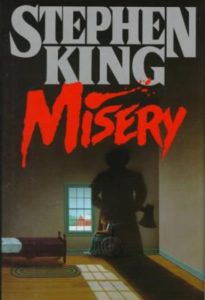 A novel about the complex and sometimes problematic relationships writers have with their fans, who expect them to keep producing the same kinds of books that they love. Paul Sheldon, a writer of Victorian romances, is rescued from a car wreck by his “number one fan,” Annie Wilkes. She becomes his number one critic when she takes him to her own home instead of a hospital to care for him and reads the manuscript of his newest novel Fast Cars, a crime novel, which he has just finished. She complains about its profanity and storyline. She then reads the newest novel in his romance series about Misery Chastain, but when she learns that he has killed off the heroine at the end of the book (so that he could move on to other projects and become a mainstream writer), she is furious and leaves him alone in her house without food, water, or the painkillers she has gotten him addicted to. When she returns, she forces him to burn the manuscript of Fast Cars and begin writing a new Misery novel in which the heroine is resurrected. Ultimately, Misery is a novel about writing a novel and readers get to see the inner workings of an author’s mind, albeit under extreme (and often bloody) circumstances. Honorable mention: The Dark Half. 1989.
A novel about the complex and sometimes problematic relationships writers have with their fans, who expect them to keep producing the same kinds of books that they love. Paul Sheldon, a writer of Victorian romances, is rescued from a car wreck by his “number one fan,” Annie Wilkes. She becomes his number one critic when she takes him to her own home instead of a hospital to care for him and reads the manuscript of his newest novel Fast Cars, a crime novel, which he has just finished. She complains about its profanity and storyline. She then reads the newest novel in his romance series about Misery Chastain, but when she learns that he has killed off the heroine at the end of the book (so that he could move on to other projects and become a mainstream writer), she is furious and leaves him alone in her house without food, water, or the painkillers she has gotten him addicted to. When she returns, she forces him to burn the manuscript of Fast Cars and begin writing a new Misery novel in which the heroine is resurrected. Ultimately, Misery is a novel about writing a novel and readers get to see the inner workings of an author’s mind, albeit under extreme (and often bloody) circumstances. Honorable mention: The Dark Half. 1989.
Link to Amazon
Historical importance to metafiction: 3
Metafictional inventiveness: 4
Literary reputation: 3
Enjoyability: 5!!!
19. O’Brien, Tim. The Things They Carried. 1990.
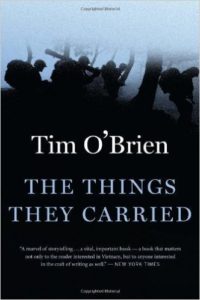 “The Things They Carried” is a short work of fiction. The Things They Carried is also the name of what could be called a short-story collection or a meta-fictional novel, a pastiche of fiction, nonfiction, fantasy, memoir, author’s notations, and literary commentary. Although the opening story stands alone as a work of fiction, it also functions as an introduction to the larger book. It establishes the major characters that recur throughout the “novel” and introduces many of the topics the book explores, themes as concrete as the Vietnam War and as abstract as how someone tells the truth about a historical event. O’Brien felt that straight facts could not convey an experience as ambiguous and disturbing as the Vietnam war. Yet O’Brien does not wholly rely on fiction either. He interweaves fact and fiction in the story (and throughout the book) to give the reader a more comprehensive sense of what it was really like to fight in Vietnam, to live in the face of death, and to carry on a purposeless existence. (An extract from my popular essay The Burden of Life: Tim O’Brien’s “The Things They Carried.“)
“The Things They Carried” is a short work of fiction. The Things They Carried is also the name of what could be called a short-story collection or a meta-fictional novel, a pastiche of fiction, nonfiction, fantasy, memoir, author’s notations, and literary commentary. Although the opening story stands alone as a work of fiction, it also functions as an introduction to the larger book. It establishes the major characters that recur throughout the “novel” and introduces many of the topics the book explores, themes as concrete as the Vietnam War and as abstract as how someone tells the truth about a historical event. O’Brien felt that straight facts could not convey an experience as ambiguous and disturbing as the Vietnam war. Yet O’Brien does not wholly rely on fiction either. He interweaves fact and fiction in the story (and throughout the book) to give the reader a more comprehensive sense of what it was really like to fight in Vietnam, to live in the face of death, and to carry on a purposeless existence. (An extract from my popular essay The Burden of Life: Tim O’Brien’s “The Things They Carried.“)
Link to Amazon
Historical importance to metafiction: 3
Metafictional inventiveness: 4
Literary reputation: 4
Enjoyability: 3
20. Danielwsi, Mark Z. House of Leaves. 2000.
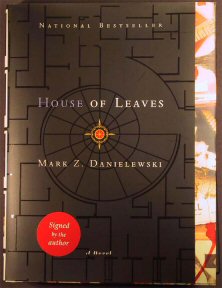 The house of leaves is the book itself, a structure made of leaves of paper, a story told by multiple narrators in crisscrossing narratives making up either a horror or a love story. As soon as you open the book, you know you are looking at different kind of book. Pages have strange layouts, sometimes the writing is sideways, some pages are nearly blank. Footnotes have footnotes. The footnote is a favorite tool of metafictionalists because it disrupts traditionally linear narrative. You cannot read the book from cover to cover. You will have to jump around and use several bookmarks, a couple fingers, and maybe a toe or two.
The house of leaves is the book itself, a structure made of leaves of paper, a story told by multiple narrators in crisscrossing narratives making up either a horror or a love story. As soon as you open the book, you know you are looking at different kind of book. Pages have strange layouts, sometimes the writing is sideways, some pages are nearly blank. Footnotes have footnotes. The footnote is a favorite tool of metafictionalists because it disrupts traditionally linear narrative. You cannot read the book from cover to cover. You will have to jump around and use several bookmarks, a couple fingers, and maybe a toe or two.
Link to Amazon
Historical importance to metafiction: 3
Metafictional elements: 5
Literary reputation: 3
Enjoyability: 3
21. Mitchell, David. The Cloud Atlas. 2004.
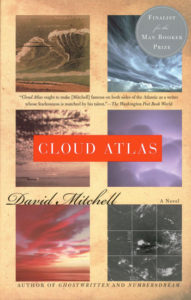 A series of six stories nested inside one another, like Russian matryoshka dolls, spanning centuries from the South Pacific in the eighteenth century to a post-apocalyptic Earth. Each story appears in the following story as a manuscript that influences the protagonists in the next story, demonstrating how no text is an island, culture is a continuum. Every story depends on those that came before it. Mitchell’s book is truly a book of book, exploring the many forms a story can be told in: journal, letters, mystery novel, satire, interview, and oral history. The metafictional moral? We are the stories we tell about ourselves.
A series of six stories nested inside one another, like Russian matryoshka dolls, spanning centuries from the South Pacific in the eighteenth century to a post-apocalyptic Earth. Each story appears in the following story as a manuscript that influences the protagonists in the next story, demonstrating how no text is an island, culture is a continuum. Every story depends on those that came before it. Mitchell’s book is truly a book of book, exploring the many forms a story can be told in: journal, letters, mystery novel, satire, interview, and oral history. The metafictional moral? We are the stories we tell about ourselves.
Link to Amazon
Historical importance to metafiction: 2
Metafictional inventiveness: 4
Literary reputation: 4
Enjoyability: 4
Honorable mentions:
O’Nolan, Brian. At Swim Two Birds. 1939
Gardner, John. Grendel. 1971.
Adams, Douglas. Hitchhiker’s Guide to the Galaxy. 1979.
Eco, Umberto. The Name of the Rose. 1980.
Wallace, David Foster. Infinite Jest. 1996.
One thought on “Top Twenty One Metafictional Works: The Story That Swallows Its Tale”